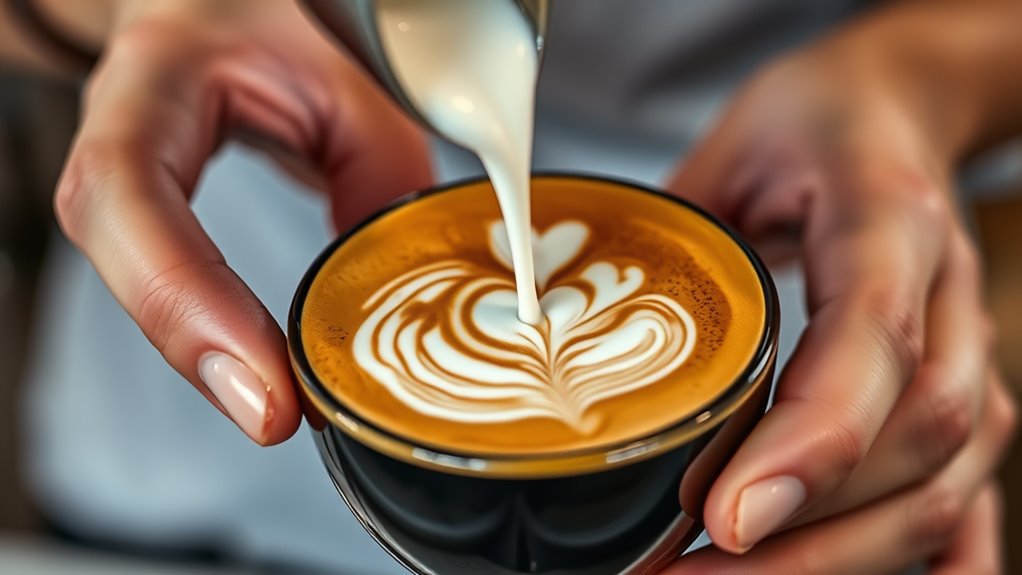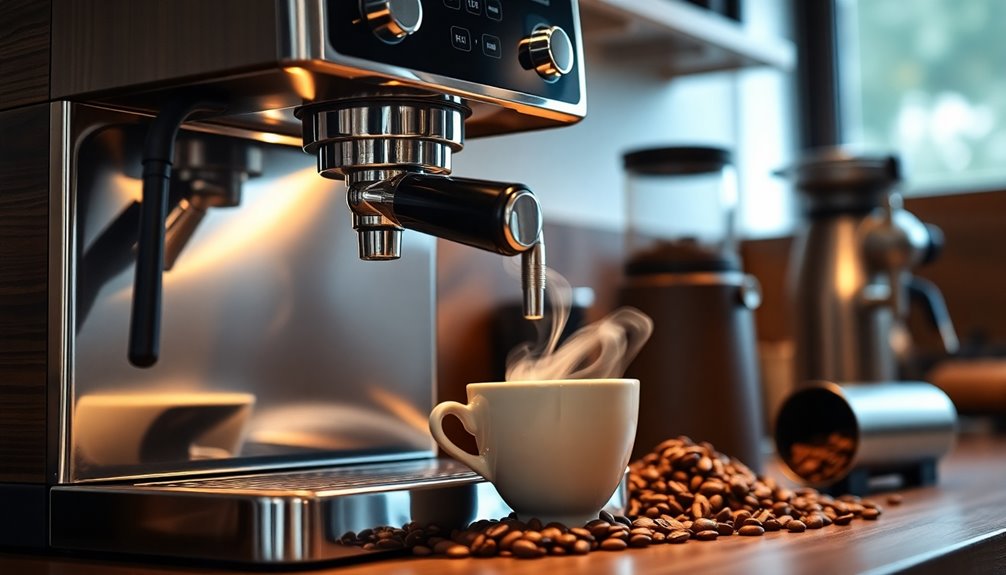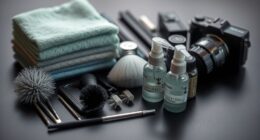Many baristas overlook consistent practice, but pros know that deliberate repetition is essential for mastering latte art. Focused training helps you develop steady hands, refine pouring techniques, and perfect your microfoam. Watching tutorials, analyzing your own pours, and practicing regularly build confidence and skill over time. If you keep working on these fundamentals, you’ll see your designs improve steadily—there’s always more to learn if you stay committed.
Key Takeaways
- Regularly practice pouring with different patterns to build muscle memory and improve control.
- Study professional baristas’ techniques through tutorials and observe their movements closely.
- Analyze your own latte art to identify areas for refinement and consistency.
- Focus on perfecting milk texture and microfoam for smoother, more precise designs.
- Dedicate consistent, focused practice sessions rather than occasional attempts to develop skill.
Mastering Latte Art: Key Techniques and Practice Tips

Practicing latte art is an essential step for anyone looking to elevate their coffee presentation skills. To master this craft, you need to focus on the fundamentals, starting with how you handle milk pouring and perfect design techniques. When you pour milk into the espresso, your goal is to create smooth, controlled movements that allow the milk’s microfoam to flow seamlessly into the shot. The way you pour directly impacts the design outcome, so it’s vital to develop a steady hand and a good understanding of milk consistency. Begin by pouring from a height to integrate the milk into the espresso, then gradually lower the pitcher to guide the foam into the shape you want. Practicing this step repeatedly helps you develop muscle memory, making your pours more precise and confident over time. Additionally, understanding the 16PF personality traits of yourself and others can help you identify the best learning style and approach to practice effectively. Design techniques are the backbone of impressive latte art. Once you get comfortable with pouring, you can experiment with various patterns like hearts, rosettas, and tulips. Each design requires a slightly different pouring approach, so it’s important to observe how your movements influence the final look. For example, creating a heart involves pouring steadily and then quickly drawing through the center with a slight wiggle, while a rosetta demands a layered, zig-zag motion as you pour. These techniques demand patience and practice, but with each attempt, you’ll start to see your designs become cleaner and more consistent. Watching tutorials, studying professional baristas, and analyzing your own pours allow you to refine your technique and develop your own style. Another key element is maintaining the right milk temperature and texture. Too hot, and the milk will be difficult to pour smoothly; too cold, and it won’t have enough microfoam. The milk should be velvety and glossy, which makes pouring easier and results in better designs. Practice pouring with different amounts of milk to see how it affects your ability to create clean lines and intricate patterns. Over time, you’ll learn to adjust your pour speed, angle, and pressure to produce the desired effect effortlessly. Consistent practice is what separates amateurs from pros. Dedicate time daily or weekly to focus solely on pouring technique and design execution. Keep track of your progress and don’t get discouraged by initial imperfections — they’re part of the learning process. Remember, even seasoned baristas spend hours honing their skills, so patience and persistence are key. With dedication, your latte art will not only improve visually but also become an expression of your growing confidence and craftsmanship.
Frequently Asked Questions
How Long Does It Take to Perfect Latte Art Skills?
It takes anywhere from a few weeks to several months to perfect your latte art skills. During this time, you’ll focus on milk frothing to get smooth, velvety textures and refine pouring techniques for clean, defined designs. Consistent practice is key—by dedicating time daily, you’ll notice steady improvement in your ability to create intricate patterns. Stay patient and persistent, and your latte art will become more impressive over time.
What Tools Are Best for Practicing Latte Art at Home?
Think of your tools as the artist’s brushes—your milk pitcher and a good thermometer are essential for perfect foam consistency. Use a stainless-steel pitcher with a narrow spout to master pouring techniques, allowing you to create intricate designs. A digital thermometer helps maintain the right temperature, ensuring smooth milk. Practice with these tools regularly, and you’ll see your latte art skills bloom, like a flower opening to the sun.
Can Latte Art Improve With Just Daily Practice?
Yes, your latte art can improve with just daily practice. Focus on simple techniques and fancy designs as you gain confidence. Incorporate beginner tips like consistent steaming and pouring height. By practicing daily, you’ll develop better control and precision, making your designs more refined. Over time, even small improvements will boost your skills, allowing you to create impressive latte art effortlessly and enjoyably.
Are There Common Mistakes Beginners Should Avoid?
You should avoid common mistakes like pouring with milk too hot or cold, which affects flow and design. Focus on maintaining the right milk temperature, ideally around 140-150°F, for smooth, glossy microfoam. Additionally, refine your pour technique by starting with steady, controlled movements and pouring from a consistent height. These adjustments help improve your latte art and prevent unwanted flaws in your designs.
How Do I Maintain Consistency in My Latte Art Designs?
Did you know that 80% of baristas say consistent milk temperature and pouring techniques are key to perfect latte art? To maintain this consistency, keep your milk between 140-150°F and practice steady, controlled pours. Focus on developing a rhythm, and don’t rush. With regular practice and attention to your milk temperature and pouring technique, your designs will become more uniform and impressive over time.
Conclusion
Don’t overlook the importance of consistent practice in perfecting your latte art. Even pros spend hours honing their skills, and studies show that dedicated baristas improve their pouring technique by up to 30% within just a few months. Keep experimenting, stay patient, and enjoy the process. With persistence and attention to detail, you’ll soon be creating stunning designs that impress every time. Remember, great latte art starts with passion and practice.










